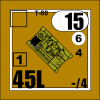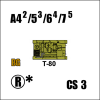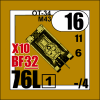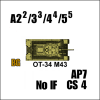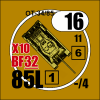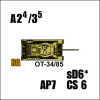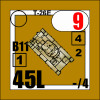
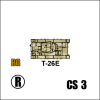
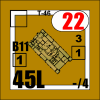
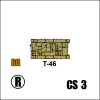 6a T-26E & T-46:
6a T-26E & T-46:
A T-26 tank with additional armour plating (appliqué armour). was sometimes referred to as T-26E (E stands for ekranirovanny or "screened"). The Factory No. 174 developed the design of 30–40 mm appliqué armour for all types of single-turreted T-26s during the Winter War. On 30 December 1939, factory tests proved that the T-26 with appliqué armour successfully resisted fire from a 45 mm anti-tank gun at a range from 400–500 m. Side and front armoured plates were mounted with the use of blunt bolts and electric welding. Toward the middle of February 1940, the RKKA received 27 screened T-26 mod. 1939 tanks (Russian Vehicle
Note 6) and 27 KhT-133 (Russian Vehicle
Note 7) flame-throwing tanks; an additional 15 T-26 mod. 1939 tanks were armoured by workshops of the 8th Army in Suoyarvi in the beginning of March 1940. All in all, 69 T-26s with appliqué armour were used during the Winter War and 20 more were delivered to tank units after the end of the war. Combat use proved that Finnish light anti-tank guns could not penetrate the armour of these tanks.
The T-26 mod. 1939 with appliqué armour weighed 12 tonnes (13 short tons), which caused an overload of the chassis, transmission, and engine of the light tank. Drivers were advised to use low gears only.
During the Great Patriotic War, a mounting of 15–40 mm appliqué armour on about a hundred different T-26s was performed by local factories in Leningrad in 1941–1942, during the Siege of Odessa (1941), the Battle for Moscow and the Siege of Sevastopol (1941–1942). A cutting of armoured plates was more rough than developed during the Winter War; the majority of these modified tanks did not have a moving armoured gun mask as seen in Factory No. 174's original design, and some tanks had front appliqué armour only.
The Soviet T-46, began as an improvement to the T-26. The T46 served the same purpose as the T26, but it was quite different. It was a fast and lightly armoured tank. It could reach speeds of up to 50 km/h with relative ease. The T-26 suspension consisted of eight small road wheels carried in pairs on small bogies. The bogies were supported in pairs by leaf springs. This was a much less effective system than the Christie suspension, which had a more advanced, yet more expensive system to maintain and produce. This is the reason why the OKMO team at Zavod No.185 was ordered by the Government of Soviet Union to produce an improved version of the fast light-tank, T-26. Yet the design of the T-46 has proved being too expensive, compared to the final performance of the vehicle to mass-produce. The thin armour, small main armament and the bulky, big design of tank, made the government of Soviet Union cancel the project, and rather create the T-26S and later T-46S, as the improved, mass-production capable tanks.
Yet some legacy left over by the T-46S, a later improved version of the T-46 lived on to see the battles in Finland.
See also Russian Vehicle Notes
Note M,
Note P.
